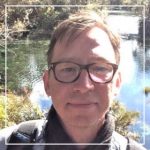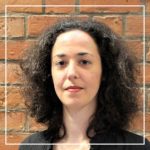‘The last time I saw my friends, I was invited to their place inside the refugee camp for lunch. It was long before the introduction of coronavirus quarantine. When I entered their container, I bent to hug and kiss them on both cheeks, as we always did when we met. However, they kept me at a distance: “Excuse me my dear! I’m afraid of coronavirus. Would you like alcohol for your hands?” Their first act of welcoming was antiseptic to protect themselves and me.’ (Chrysi’s fieldwork diary, 19/2/2020)
The protagonists of the vignette, refugees in a Greek reception centre, understood the threat of coronavirus through family and friends in countries affected by the virus. Awareness of the threat and measures to prevent its spread were raised through official reports and word of mouth. The edges of the threads of the pandemic reached them through the virtual connections with concerned friends and family.
We use the binary classification ‘we/us’ and ‘they/them’ to illustrate divisions between host-citizens and (unwelcome) refugees, which permeate the politics of exclusion. While we explicitly do not endorse this terminology, our experience and the specific vignette is articulated around it. Othering, perceiving through the pejorative ‘them’, is not exclusive to refugees, but rather refers to other people perceived as migrants just as well, as the following example illustrates. ‘I was shocked as a stranger passed me by, gesturing to a single Asian pedestrian across the road. “Careful”, the stranger said, “they’ll have the [corona] virus].” (Tom’s fieldwork notes in the early stages of the coronavirus pandemic, 1/3/2020)
Some camp residents considered the threat of an invisible virus insignificant compared with surviving wars, deprivation, shootings at border-crossings, and other threats they had faced. Nevertheless, camp residents sought to prevent coronavirus spread much earlier than we had become worried about the pandemic, let alone took precautions.
‘Before eating the lunch prepared by my friend and served in perfectly geometric arrangements, pleasant to sight and taste, we cleaned our hands again with alcohol. However, what struck me was not the food, hospitality, or the care for our health. It was the feeling of the space. Everything was perfectly clean and ordered, so that not one square centimetre of the minimal space was wasted. Yet I felt suffocated. It was two steps from my chair on the one side of the room to the bed placed against the opposite (plastic) “wall”. The bed was too small for couple in a space shared by a small family. I felt discomfort in this situation. It was obvious to me that this “accommodation” was not made to meet people’s needs; instead, the space was allocated to them. The residents have no other choice but to fit into this space.’ (Chrysi’s fieldwork diary)
Some camp residents considered the threat of an invisible virus insignificant compared with surviving wars, deprivation, shootings at border-crossings, and other threats they had faced.
Residents of the camps face additional burdens. Having fled from ravaged societies, the novel-coronavirus (hereafter coronavirus) and the ensuing restrictions of quarantine add enormously to refugees’ vulnerability and their physical and emotional precarity. The biosocial perspective of syndemic vulnerability enables us to consider the multi-layered intersections that impact refugees (ill) health. Syndemic vulnerability ‘describes situations in which adverse social conditions, such as poverty and oppressive social relationships, stress a population, weaken its natural defences, and expose it to a constellation of potentially adversely interacting diseases’ (Baer et al. 2013: 315). A biosocial approach avoids a reductionist perspective of disease because it ‘is focused on the ways in which biology and society interact to shape health’ (Baer et al. 2013: 306). Furthermore, dominant political paradigms impact further the vulnerability to disease as we elaborate below, a prime example being the policy of putting camps in lockdown.
Refugees are syndemically vulnerable in the refugee camp where past and present social and biological precarities collide, exacerbated by state-sanctioned isolation within overburdened and confined spaces. Syndemic vulnerability provides a perspective on the normality of a friendly welcome (albeit with social distancing and antiseptic) which belies the lived reality of layers of fleeing trauma and current confinement.
Contrast the situation described above with that experienced by many members of the host society, who can implement social distancing to help limit the spread of coronavirus. Conversely, refugees, often perceived as carriers of actual and potential infection (Khan et al. 2016; see also Ahmed 2004), are controlled through enhanced restrictive policies. The principle of infection control through isolation has been declared necessary for humanity. However, the isolation controls imposed on refugees intensify their already cramped living existence. Refugee camps are symbolic of states’ humanitarian understanding of Othered populations. Residents’ needs are reduced to the minimum for survival. Camps are viewed as potential simmering pots of infection, literally and metaphorically, and a danger to host-citizens who live many kilometres away.
Refugees are syndemically vulnerable in the refugee camp where past and present social and biological precarities collide, exacerbated by state-sanctioned isolation within overburdened and confined spaces.
Refugees reconstructed in this biosocial-political paradigm are a body to be feared. The gates of camps are locked and guarded to ensure that the imagined status of the residents as embodying infection risk, remains contained.

Photo courtesy of United Nations, via Unsplash
Isolation and Social Distance
The implementation of quarantine as a measure to limit the spread of coronavirus leads us – members of the host society, at least the privileged ones with roofs over their heads – to our homes and refugees in Greek reception centres to their camps. For us, “staying at home” already fulfils the demands for “social-distancing” and “isolation” vital for our (and ‘society’s’) protection from the pandemic. For us, “staying at home” is difficult, and going out is an adventure. For them, residents of reception centres, “staying at home” means remaining in their allocated room; “home” is a plastic container shared with family members, other refugees, or other families. “Going out” means walking around the paths of the overcrowded camp. Furthermore, each week, one person per container is allowed to leave the camp to procure supplies for members of the allocated “home”.
Refugees reconstructed in this biosocial-political paradigm are a body to be feared.
Refugee reception centres are located on Greek territory – thus, refugees have already managed to pass through Europe’s borders. The presence of refugees in Greece is officially recognised, and what is now pending is the prospect of their integration (see Titley 2012). Yet refugee reception centres are outside of urban areas. Excluded from urban surroundings, they are marked further by surrounding walls and/or fences; gates are monitored by security guards and police. In this way, national borders become visually represented by the state within its territory, to mark the space allocated to asylum seekers. The desire to keep out whomever does not belong to what has been imagined as constituting the “host” (physically and politically), even as they are already inside, is visualised by these boundaries (see Brown 2010). In times of “normality”, boundaries are allegedly for the protection of the residents of the camp.
The current emergency reinforces boundaries because of fear of the pandemic or the detection of coronavirus in specific camps. Those supposedly responsible for the protection of the refugees closed the camp’s gates to prevent residents from leaving, ensuring the well-being of the distant (host) society.
One might wonder whether refugees are isolated and restricted, perversely not for their own well-being but for the biological safety of the host population.
Those supposedly responsible for the protection of the refugees closed the camp’s gates to prevent residents from leaving, ensuring the well-being of the distant (host) society.
While isolation is one infection control measure, practically, refugees’ state-imposed isolation increases rather than reduces cross-infection. The biopolitical landscape exposes refugees in reception camps to syndemic vulnerability and structural exclusion, exposing them to additional, overlapping, and aggravated vulnerability, social precarity and biological infection. Furthermore, living conditions contribute to disease exacerbation, ‘social and environmental factors … promote and enhance the negative effects of disease interaction’ (Singer et al. 2017: 941). We apply this argument to the social and environmental conditions and disease amplification in refugee camps where residents are ‘transformed… into disposable bodies’ (Kober and Re Cruz, 2017: 135). The cramped space of a refugee camp, and the politics of exclusion, do not allow room for the segregation of infected and non-infected residents. For refugees, keeping social distance is practically impossible.
The impossibility of keeping social-distance increased awareness – at least for the protagonists of the vignette – of vulnerability, enhancing the sense of self-responsibility for their own biosocial well-being, as well as those who live with them.
Ironically and realistically, it was Chrysi, coming ‘from the city’, a space ‘out of the camp’, who might carry the virus. To break the chain of spreading it, Chrysi had to be disinfected before touching anything or anybody within the container.
Differentiating subjects on spatial terms
The logic that supports refugees’ space allocation relates to how they are perceived by those in privileged positions. Nyers discussing the (socio-political) position refugees hold, focuses on the ‘primary political category of the modern era’, ‘sovereignty’ (2006: xi). This sovereignty ensures political order by ‘establishing the conditions for legitimate authority over time and within a particular space’ (ibid.). The spatial approach involves the constitution of identities based on legitimate belonging within the dominant political landscape. Thus, those who possess legitimate belonging are privileged with allocating space to those [refugees] who are not [currently] entitled to equal rights, or rather their ‘right to have rights’ (see DeGooyer et al. 2018 for a recent take on Hannah Arendt’s work). Refugees’ rights are more conveniently put under discussion, as recent developments have elaborately shown.
The impossibility of keeping social-distance increased awareness – at least for the protagonists of the vignette – of vulnerability, enhancing the sense of self-responsibility for their own biosocial well-being, as well as those who live with them.
Ong argues that Foucault’s conceptualisation of biopolitics ‘refers to the strategic use of knowledges which invest bodies and populations with properties making them amenable to various technologies of control’ (1995: 1243). Biopolitical strategies are restrictive and reductionist, not progressive. Biopolitics constructs the refugee as a viral organism and not a living, feeling, thinking and connected human with biosocial needs. Refugee camps, especially in lock-down, restrict those embodied as imagined sites of infection, ensuring residents are exposed to (coronavirus) infection and re-infection; currently, it is uncertain if past coronavirus infection provides immunity. Perceived as super-vectors of infection, refugees are restricted by the state, a view supported and mediatised by like-minded proponents. Refugees become unwelcome on a basic level and a danger to life and society on a macrolevel, as they are ‘construct[ed] as the contagious Other’ (Ong 1995: 1245).
Restriction in a place of syndemic vulnerability exposes refugees to additional biosocial disadvantages exacerbating their marginalisation and susceptibility to diseases.
The state acts to reify refugees’ perceived biosocial status as “infected”. Billions of dollars and its equivalents are provided for state-citizen’s health. Nevertheless, refugees are deemed less human and undeserving of improved living spaces without the fear of infection and a heightening possibility of death. The millions spent making refugees’ settlements on the margins of the host society to minimise the possibility of “infection” contributes to their susceptibility to infection and the implications this could have for “public health”.
Finally
Refugees’ syndemic vulnerability distinguishes them from host-citizens, entitled with proportionate rights (as the latter are understood). The usually cramped living conditions in reception centres exemplify that sovereignty and human rights may not move in tandem, despite the former being held responsible for ensuring the latter.
Restriction in a place of syndemic vulnerability exposes refugees to additional biosocial disadvantages exacerbating their marginalisation and susceptibility to diseases.
Refugees sheltering in reception centres are vulnerable. Vulnerability exists due to the current coronavirus pandemic restrictions and the refugees living conditions which ensure they are perceived as “infected”, literally (biologically) and metaphorically (socially). Nevertheless, it is refugees themselves, being aware of their vulnerability and conscious of their well-being, who have been striving to ensure the protection of their health.
If public health is the goal, then this goal can only be achieved when human beings sharing the same ground are granted equal access to health-services, ensuring living conditions that – as for our case – limit susceptibility to infections.
The protagonists of the vignette, like other refugees fleeing their country, exercise their right to life. From the space they are given as “asylum seekers” waiting for the outcome of their application process, they are figuring out ways not to take back their “normality”, but rather ways to develop and thrive in harsh conditions. The current lock-down for them further limits their capacity to act for their own prosperity, where options are reduced to the mere basics of bodily existence. The only choice left to exercise their agency is to protect themselves – no one else will do it for them.
If public health is the goal, then this goal can only be achieved when human beings sharing the same ground are granted equal access to health-services, ensuring living conditions that – as for our case – limit susceptibility to infections.
References
Ahmed, Sara. (2004) The Cultural Politics of Emotion. Edinburgh: Edinburgh University Press.
Baer, Hans A., Singer, Merril and Susser, Ida. (2013) Medical Anthropology and the World System: Critical Perspectives. (3rd Edn.). Santa Barbara, Denver, Oxford: Praeger.
Brown, Wendy (2010) Walled States Waning Sovereignty. New York: Zone Books.
DeGooyer, Stephanie, Hunt, Alastair, Maxwell, Linda and Moyn, Samuel (2018) The Right to Have Rights. London and New York: Verso.
Khan, Mishal, S., et al. (2016) Pathogens, Prejudice, and Politics: The Role of the Global Health Community in the European Refugee Crisis. The Lancet Infectious Diseases, 16, no. 8: e173-e177.
Kober, Ryan. and Re Cruz, Alicia (2017) Fluid Vulnerabilities of the Living Border: Central American Asylum Seekers in Texas. In Haines, David, Howell, Jayne, and F. Keles Maintaining Refugee: Anthropological Reflections in Uncertain Times. American Anthropological Association: A Publication of the Committee on Refugees and Immigrants.
Nyers, Peter (2006) Rethinking Refugees: Beyond States of Emergency. New York and Oxon: Routledge Taylor and Francis Group.
Ong, Aihwa (1995) Making the Biopolitical Subject: Cambodian Immigrants, refugee Medicine and Cultural Citizenship in California. Social Science Medicine, Vol. 40, No.9: 1243-1275.
Singer, Merrill., Bulled, Nicola, Ostrach, Bayla and Mendenhall, Emily (2017). Syndemics and the Biosocial Conception of Health. Lancet, 389, no. 10072: 941-950.
Titley, Gavan (2012) “Exclusion through Openness? A Tentative Anatomy of the Ritual of ‘Migration Debates’”. Collegium : Studies across Disciplines in the Humanities and Social Sciences (11): 46-69.











1 Comment